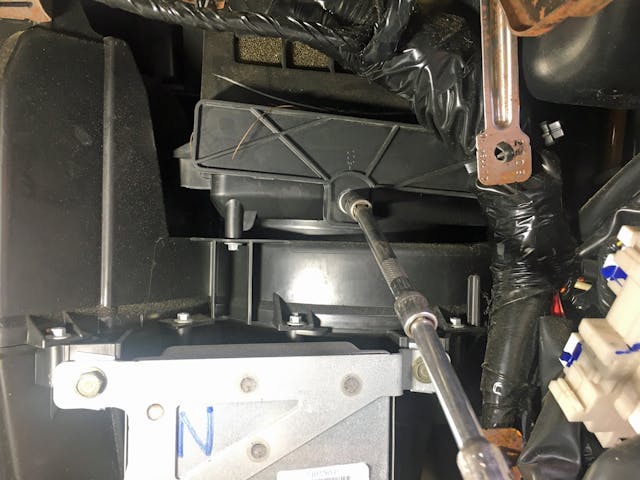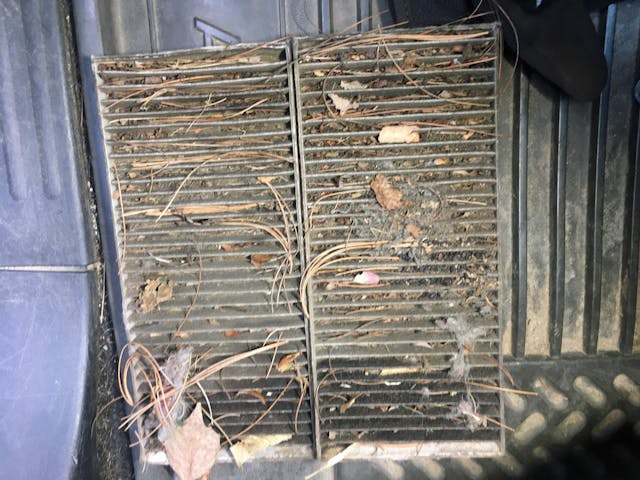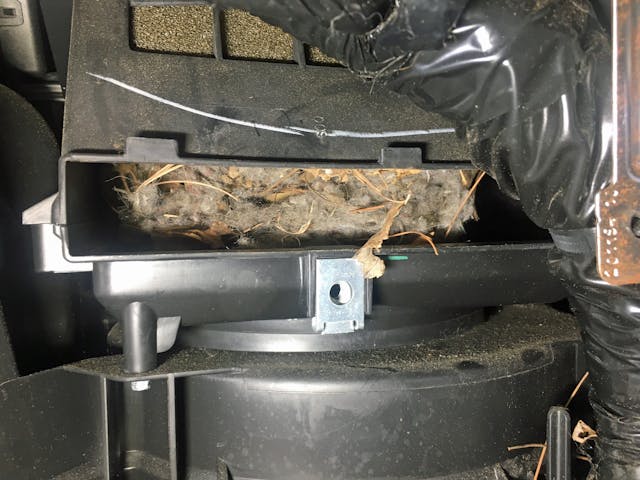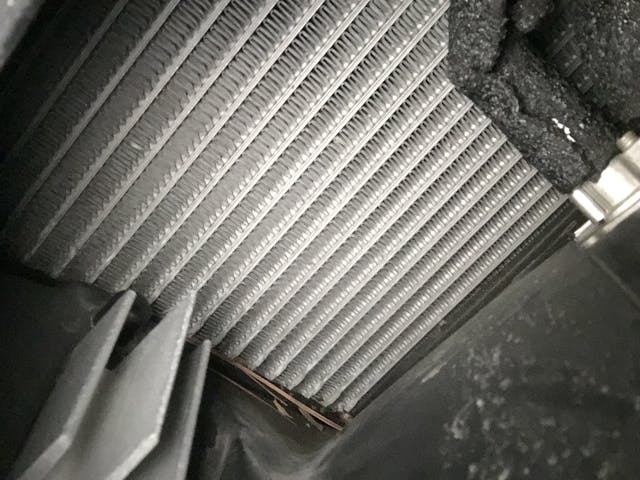Déjà Vu: The Mouse-Infested Armada
My readers will certainly recall The Case of the Mouse-Infested Truck—the 2008 Silverado I bought from my ex-employer for a song because mice had used it as both a bathroom and a casket (Google “Rob Siegel Hagerty mouse infested truck,” but be sure you don’t have a weak stomach).
So imagine how I felt when I had to admit to myself that my recently-purchased 2008 Nissan Armada—ostensibly the replacement for the Silverado—had a rodent contamination issue.
When I bought the Armada, it had been sitting on the owner’s property for a few months. As I explained here, it had a number of problems that I was aware of and several more that I wasn’t. During the short test drive, I thought I caught a rodent-tinged whiff, but it was nothing close to the gag-inducing stench from the Silverado. There was, however, an obvious climate control issue—a clicking sound emanating from the heater box. This is the characteristic mating call of worn-out plastic gears on the actuator controlling one of the blend doors. But with all the truck’s needs, these two issues didn’t even make it onto the punch list.
Once the Armada was largely sorted out and I began driving it, however, the slightly acrid, rodent-infused background smell was like a thistle thorn in a sock—annoying as hell for short periods. However, when my wife accompanied me on a short errand, she of the exquisitely sensitive sense of smell said that nothing jumped out at her. So I went to my backup position—denial. There is no smell. There. I dealt with it. Done.
Until one night. I had a gig, my daily-driver E39 BMW was sidelined in the garage, and my wife needed her Honda Fit, so I drove the Armada 40 miles in the rain each way. The combination of the closed cabin and the need to run the blower fan with fresh air to defrost the windshield made the eau-de-mouse smell jump to the foreground. My state of denial crumbled.
Damn.
The mouse-infested Silverado had been a nightmare scenario, as mice had crawled up the A-pillars into the headliner, urinated and defecated and died there, and did the same inside the heater box. To deal with it, I removed the headliner, threw it in the garbage, cleaned every metal surface on the roof and pillars with enzyme-based cleaner, and installed a new headliner. Unfortunately, I read that removing and reinstalling the heater box was something like a 12-hour job, and I wasn’t willing to do that, so instead I snaked an inspection camera down the vents and into the box, located the mouse nest, drilled an opening with a hole saw, pulled out the nest and the body of a dead mouse, and tried to clean the box using multiple treatments of pressurized disinfectant that washed out through the drip hole for the A/C condenser. It worked well enough for me to be able to use the truck (and for my wife to even ride in it with me, if necessary), but it also made me think that I would never knowingly buy another mouse-infested vehicle unless it was something I really REALLY wanted and was a smoking-good deal. The Armada was neither of these things, so the fact that I had to admit that I was facing the possibility of going through all this again really frosted my behind.
And then I had a thought: Maybe this time I’d get lucky. Yeah, let’s go with that.
Any vehicle built in the past 30 years has cabin air filters. It’s not uncommon for them to be a poster child for lack of maintenance—that is, for the filters to never be changed, and for all sort of nasty stuff to accumulate on them. Including mouse nests.
So, I said to myself, “Self, don’t panic. Check the cabin air filters.”
The location of cabin air filters varies car-to-car, but they’re usually up high on the inside of the cowl. Thus, it’s not unusual for them, or for one of them, to be above or behind the glove box. That’s where they are in the Armada. On many cars, you can reach the filter with the glovebox installed. On some, you need to unclip the glovebox so it drops further down than it normally does. But in the Armada, you actually need to unscrew and remove the entire glove box assembly, including the frame the glovebox pivots on. It was surprising, but not too bad

Once the glovebox assembly is removed, the filters are accessible. The filter cover is held in place by a single 10mm bolt.

I withdrew the two filters. They were, as we used to say in junior high, grody to the max. If they were ever replaced, it certainly wasn’t recently.

In case you need a close-up, here it is. No wonder the cabin air smelled like rodent. I became very hopeful that this was “it,” and ran inside to the laptop and put a $12 pair of filters on order for next-day delivery.

As Ron Popeil used to say, “But wait! There’s more!” Once the filters were removed, I looked back at the fresh air vent above them.
Jackpot.

This mouse nest appeared to have been completely above the filters, giving me hope that, unlike the situation in the Silverado, contamination hadn’t extended into the heater box. My iPhone inspection camera had stopped working for some reason, so instead I pulled out the blower fan to gain inspection access to the heater box. This was fairly straightforward, as it’s only held in place by three 5.5mm bolts. With the blower fan out, I could stick my phone inside the heater box and photograph it, or at least the core that the fan blows through. I saw a few stray leaves and stems, but no evidence of rodent contamination—no nests, no pellets.

Once I’d confirmed the apparently limited scope of the contamination, instead of doing the full-on pressure-washing with enzyme-based cleaner approach I did with the Silverado, I simply reached in and wiped every surface I could reach with Clorox disinfecting wipes. I also sprayed and wiped each blade of the squirrel cage of the blower fan.
Although I hate the smell of Lysol, this was good time to use it in moderation. Let me be clear about this: If there is a mouse nest, or piles of dung, or an actual carcass inside, unloading a can of Lysol into the vents as some people propose online is never going to make the smell go away. Unless you’ve located and removed the bulk source of the smell, all that spray disinfectant is likely to do is mask it. However, using a bit of spray disinfectant to chase down residual reengage molecules either above or below the actual contamination isn’t unreasonable. I reinstalled the blower fan and the filter cover but didn’t install the filters yet. I then turned the fan on high, set the climate control to fresh air, gave a blast of Lysol into the fresh air inlet in the windshield cowl, and let the blower fan suck it directly into the heater box without the filters blocking it. I let it run in my driveway for 15 minutes. Then I installed the filters and let it run for another 15.
Finally, with trepidation, I took the Armada for a drive. Windows up, fresh air selected, blower on full.
The smell was gone.
It took me a while to notice that something else was gone too—the clicking sound. Either it’s an utter coincidence, or what was happening was that the sound was coming from the fresh air vent being unable to close because it was hitting the mouse nest on top of the filter, and with it gone, it now could move unimpeded.
As I said, sometimes you get lucky.
Next, I need to look at the air conditioning. Maybe I’ll get lucky with that too.
***
Rob’s latest book, The Best Of The Hack Mechanic™: 35 years of hacks, kluges, and assorted automotive mayhem is available on Amazon here. His other seven books are available here on Amazon, or you can order personally-inscribed copies from Rob’s website, www.robsiegel.com.
Check out the Hagerty Media homepage so you don’t miss a single story, or better yet, bookmark it. To get our best stories delivered right to your inbox, subscribe to our newsletters.



I love a story with a happy ending.
I wish you the best of luck on your A/C endeavors. My poor w126 keeps getting that can kicked down the road as I can’t bring myself to spend $500 on a new compressor, and I have yet to source a decent used unit. Hopefully you won’t have such hurdles with a more modern car.
I went thought this last spring. I purchased a Corvette that had a mouse storage issue. The dealer. Removed the blower motor and cleared the heater box. They also deodorized the system. It was better but it still had debris coming out of the heater vents.
I found that there was more material that looked like the stuffing from moving pads coming out the vents. I did not want to take the dash apart so I chose a weapon of choice.
I have a Metro Airforce blaster to dry my cars. This is 8 HP of warm dry air that can be used to dry a car or clear out things in a car. Having worked on a number of Corvettes It is not unusual to find nut shells and such on a LS1, LS3 or LS6.
I used the blower to reverse the air in the system by blowing in the vents. This produced what I termed a snow storm in June. I had stuffing coming out all the vents and With a mask on I continues till nothing else came out.
I also used the new product Pooof to remove any more smell. I used the lower setting to blow it through the system. It worked.
I also have gone through the car and cleaned up more nut shells and such in various areas.
You may want to check for wire damage. It is common and in my case I have made it with no issues of wire issues. Not one chewed wire some how. This can be fatal to some cars.
I was lucky the dealer did find the roof had some damage before I bought the car. They installed a new $1500 Top that most C5 cars lack that was installed by a skilled shop. It fits better than the factory top and they installed all new seals. No leaks or wind noise.
My shop have now has been rodent free since I built it 12 years ago, We have enough feral Cats here that at night they tend to keep the rodents in check. The pet neighbor cats and I also have a understanding they are are welcome.
I had one mean old Cat Name Chong, She yes she was an FU cat and even her family was not fond of each other but we got a long. She would visit and she took care of business 24/7. I think a Coyote got her in the end but there are others to fill in.
I am not a cat fan but the ones here are a help to me.
This was my first issue with mice on my own cars. I have cleaned up others but they are always lurking.
Hyperv6, sorry to ask but you said you aimed the blower in a vent. There are three dash vents and one floor vent on a C-3. Are you saying the debris is coming out the fresh air intake or the other cabin vents? Also what do you have the dial on the console set at, vent?
I believe he (Hyperv6) said he has a C-5.
Uggh, another mouse issue. At least this one was nowhere as bad as your silverado and was an easy fix.
Ozium is great for eliminating odors after cleaning out the air ducts and before replacing the cabin filters. Introduce it through the cabin air intakes with the fan on high. Repeat for each vent selection position on the heater controls. With the system in recirculate, locate the air intake ducts (usually the heater outlets under the dash) and spray some in that way as well. If you are serious about long-term odor destruction, invest in an ozone/negative-ion generator. There is one for less than $50 on Amazon right now. Place the generator in the car, turn it on, then idle the vehicle for an hour with the windows closed, climate control on recirculate and the fan on high. If one treatment doesn’t do the job, another one probably will. Finish off by installing carbon impregnated cabin filters that will absorb any lingering odors.
Rob, I enjoyed reading your Armada experience and thanks for sharing your victory with us readers! Finding evidence of a dead rodent in our beloved cars is nearly as bad as finding evidence of a live rodent. But that memory jogging eau-de-dead-mouse smell is so hauntingly visceral that even reading about it brought me back to my past battles with many a rodent offender. Ugh, if only they could find better places to nest and die.
I have had success with keeping rodents away from my outside car and in my garage with Rodent Bags that I purchased from my local ACE Hardware store. They come in a box of four for $20.00. The bags contain balsam wood shavings and they should last for the winter season. In my garage, I also placed two plug-in high frequency sound generators that also seem to work. Biggest hassle I have is that I have to remind myself to remove the rodent bags from the engine compartment of my outside car before getting underway.